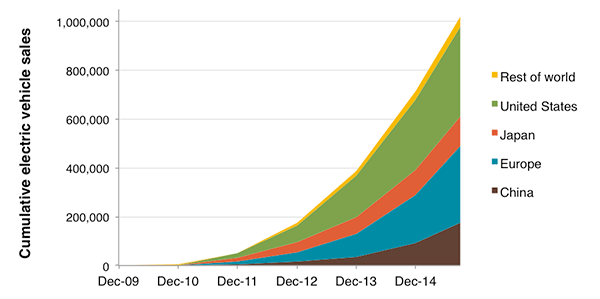Transition to a global zero-emission vehicle fleet: A collaborative agenda for governments
Blog
Global milestone: The first million electric vehicles
Milestones are important, and numbers, especially large round numbers, make good ones. The automobile was born in 1879. Probably a little more than three decades later the millionth automobile took the road, in about 1912–1913. Now, a century on, with a world population of more than a billion vehicles, the automobile is a core element of personal mobility—and we may be approaching a great turning point in the history of the auto: the transition from internal combustion to electric vehicles. One reason to think so is that we’re about to pass another milestone: this month, somewhere in the world, the millionth modern plug-in electric vehicle will take the road.
This milestone, most impressively, was achieved in about 6 years—several years faster than it took for non-plug-in hybrid electric vehicles. In that comparatively short span, automakers have manufactured, marketed, and sold a million electric vehicles—and, of course, a million drivers, households, and fleet drivers got accustomed to this new advanced, low-carbon technology. Supply chain growth, charging infrastructure deployment, innovative state and local policy, and power utility promotions have all helped enable the transition to the new technology. For context, a million vehicles is about the average annual new automobile sales in Spain, Mexico, or Indonesia.
The chart below (based primarily on data from ev-sales.blogspot.com) shows the progression to date in electric vehicle sales. The figure shows cumulative electric vehicle sales globally from 2009 through September of 2015, with a breakdown of the major markets. Globally, we’ve seen the rise of electric vehicles primarily in North America, Europe, and Asia. The U.S. represents about 36%, Europe 31%, China 17%, and Japan 11% of the first million plug-in vehicles. Looked at from an industry perspective, the leading companies are Renault-Nissan, Mitsubishi, Chevrolet, Tesla, Toyota, Ford, BMW, and Volkswagen; together they manufactured over 80% of these first million vehicles.

Cumulative electric vehicle sales globally through September 2015
Beginnings are important, too. And this month will also see an important beginning: the launch of a new consortium of governments, the International Zero-Emission Vehicle Alliance (ZEV Alliance), aiming to accelerate the transition to a global fleet of electric vehicles—to make sure that we reach that turning point.
The coincidence is auspicious. Just as the million-electric-vehicle milestone is achieved, these governments are coming together to spur deployment of the next crop of electric-drive vehicles. Catalyzed initially by California, Québec, and the Netherlands, the governments of California, Connecticut, Maryland, Massachusetts, the Netherlands, Norway, Oregon, Quebec, Rhode Island, the United Kingdom, and Vermont are coming together to found the ZEV Alliance. The governments of the ZEV Alliance are committed to electric vehicles in an effort to reduce greenhouse gas emissions and air pollution, decrease the consumption of petroleum, and support the growth of a clean global economy. To date, these 11 governments have more than pulled their weight in spurring the early ZEV market. The auto markets represented by these governments represent almost 40% of global electric vehicle sales, compared to just 7% of overall car market. Participating governments will cooperate on setting ambitious but achievable ZEV deployment targets, share data and best practices, and encourage other governments to join.
Our new study, “Transition to a global zero-emission vehicle fleet: A collaborative agenda for governments,” highlights how the early leading electric vehicle markets are being shaped by new and innovative public policies and how governments can further collaborate to accelerate electric vehicle adoption. The research indicates how critical a global fleet of electric vehicles is going to be for society to achieve long-term climate goals (e.g., see here, here, here, and here). Tens of millions of electric vehicles will likely be needed in the decades ahead.
The first million is a good start. But there’s still a long road ahead. With the global fleet headed rapidly toward two billion vehicles, electric vehicle growth will really have to pick up if we are to achieve international climate targets. And so the International ZEV Alliance is a beginning to celebrate, too.
